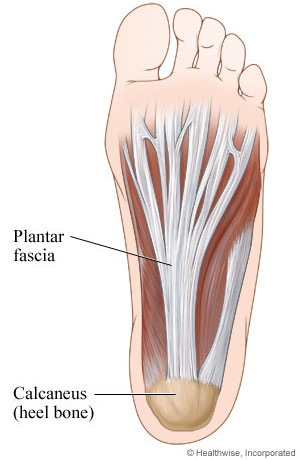Plantar Fasciitis
What is plantar fasciitis?
Plantar fasciitis (say "PLAN-ter fash-ee-EYE-tus") is pain in your heel or the bottom of your foot. It happens when the flat band of tissue (ligament) that supports the arch of your foot is inflamed or irritated.
Plantar fasciitis is common in middle-aged people. It also occurs in younger people who are on their feet a lot, like athletes or soldiers. It can happen in one foot or both feet.
Symptoms
What are the symptoms of plantar fasciitis?
The main symptom of plantar fasciitis is heel pain when you take your first steps after you get out of bed or after you sit for a long time. It gets better after a few steps but gets worse as the day goes on. You may also have:
- Pain that gets worse when you climb stairs or stand on your toes.
- Pain after you stand for long periods.
- Pain at the start of exercise. It gets better or goes away as exercise continues, but it comes back when exercise is done.
Plantar fasciitis may be mistaken for other conditions with similar symptoms, such as a stress fracture or a nerve problem such as tarsal tunnel syndrome.
Plantar Fascia: Bottom View

The plantar fascia is a ligament attached to the heel bone (calcaneus) that divides and fans out to attach at the base of the toes.
Diagnosis
How is plantar fasciitis diagnosed?
To diagnose plantar fasciitis, your doctor will ask questions about:
- Your past health. This includes what illnesses or injuries you've had.
- Your symptoms. Examples are where the pain is and at what time of day your foot hurts most.
- How active you are.
- What types of physical activity you do.
If you are an athlete, your doctor may look for other problems. These may include issues with how your feet strike the ground, how your feet are shaped, or your training routine.
X-rays aren't helpful in diagnosing plantar fasciitis because they don't show ligaments clearly. But you might get X-rays if your doctor suspects a stress fracture, a bone spur, or some other foot or ankle bone problem.
Treatment
How is plantar fasciitis treated?
No single treatment works best for everyone with plantar fasciitis. But there are many things you can try to help your foot get better.
- Give your feet a rest. Cut back on activities that make your foot hurt. Try not to walk or run on hard surfaces.
- To reduce pain, try putting ice on your heel. Or take an over-the-counter pain reliever.
- Do passive toe stretches, standing calf stretches, and seated calf stretches using a towel several times a day, especially when you first get up.
- Get a new pair of shoes. Pick shoes with good arch support and a cushioned sole. Or try heel cups or shoe inserts (orthotics). Use them in both shoes, even if only one foot hurts.
If these treatments don't help, your doctor may recommend splints that you wear at night, shots of medicine (such as a steroid) in your heel, surgery, or other treatments.
Copyrighted material adapted with permission from Healthwise, Incorporated. This information does not replace the advice of a doctor.
